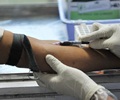The hepatitis C virus (HCV)is triggered off in its infectious activity by an enzyme connected to the fat that is stored in the liver, conclude scientists.

The study by the researchers at the Gladstone Institute of Virology and Immunology (GIVI) shows that the enzyme DGAT1 is a key factor in HCV infection.
With several potential DGAT1 inhibitors already in the drug-development pipeline, a treatment for HCV may be possible in the near future.
"Our results reveal a potential 'Achilles heel' for HCV infection," Nature quoted Melanie Ott, senio r author on the study, as saying.
"Several DGAT1 inhibitors are already in early clinical trials to treat obesity-associated diseases. They might also work against HCV," said Ott.
It has been recently shown that fat droplets are critically involved in the HCV lifecycle and DGAT1 helps in their formation.
Advertisement
"We found that HCV specifically relies on one DGAT enzymes, DGAT1. Whe we inhibit DGAT1 with a drug, the liver still produces fat droplets through another DGAT enzyme but these droplets cannot be used by HCV," said lead author Eva Herker.hey found that DGAT1 interacts with one viral protein, the viral nucleocapsid core protein, required for viral particle assembly.
The study was published in the journal Nature Medicine.
Source-ANI















